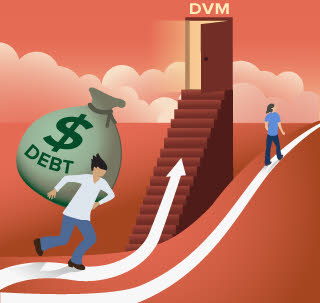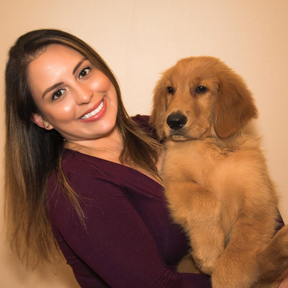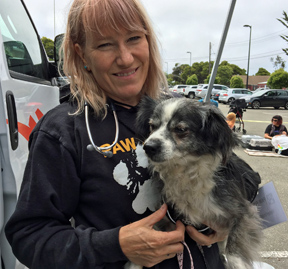Different paths

Michelle Jara was working as a receptionist in a veterinary specialty practice in Miami and preparing to apply to veterinary school when she heard something she'd never heard before.
The message was delivered by an intern at the practice, Dr. Allison Ward. As Jara recalled, Ward began the conversation casually.
"So, you want to go to vet school?" she asked.
"Yeah, I do," Jara, 23, responded. She'd dreamed of being a veterinarian since she was a child.
"Maybe you don't," Ward suggested, her own student debt of $360,000 in mind.
"What do you mean I don't want to go? I love animals." Jara fired back angrily. "This is what I'm meant to do!"
"Michelle," Ward responded, "Let's talk about it."
And talk they did, for much of the year that Ward and Jara worked together, from July 2012 until the following summer. They pored over school costs and salary estimates and consulted debt repayment calculators.
Jara, who had already accrued $100,000 in undergraduate debt, faced a financial reality shared by all veterinary students: It's expensive. Very expensive. Total tuition paid by the class of 2020 at U.S. veterinary schools ranged from about $78,000 to $319,000 per graduate, according to information in the Association of American Veterinary Medical Colleges cost comparison tool.
As a result, most veterinary students must borrow money to attend school, and they commonly graduate owing $100,000 to more than $400,000. Considering the comparatively low expected starting salary of around $91,000 — a figure reported at the latest American Veterinary Medical Association Economic Summit — the financial aspects of veterinary school are daunting.
But oftentimes, the financial reality doesn't fully sink in until after graduation when the debt comes due. The VIN News Service interviewed two women who scrutinized the numbers before committing to veterinary school. Although equally passionate about careers in caring for animals, the aspiring veterinarians came to opposite decisions.
Inconsistent financial education
Michelle Jara

Alejandro Heredia Photography
Michelle Jara, shown with her dog Cooper, has always loved animals and grew up assuming she would become a veterinarian.
Jara lamented that she received no financial guidance during her undergraduate days at the University of Miami, where she pursued a pre-veterinary track in biology and ecosystem science and policy.
Just 17 when she started college, she remembers a perfunctory meeting with financial aid advisers who did not bother to explain what forms of assistance they were proffering. "They called it financial aid; told me to 'sign here,' " Jara said. "I was never given an option for different types of aid or anything of that sort, so the majority of my loans unfortunately are private," she said.
Unlike federal student loans, private loans made by institutions such as banks may require payments while students are still in school, likely require a co-signer, may have higher interest rates, cannot be consolidated into a federal consolidation loan, and do not come with long-term income-driven repayment or loan forgiveness options.
Jara ended up with $100,000 in school debt upon graduation in 2010, nearly four times the average undergraduate debt that year of $25,250. During her time working at the practice in Miami, she made monthly loan payments of $600.
So when her co-worker broached the subject of the cost of veterinary school, Jara already was a bit worried about her existing debt.
Across the country and around the same period, Josie Noah was dreaming of veterinary school and confronting similar financial questions: Could she afford it? Was it worth it?
Unlike Jara, Noah, then 37, had been full time in the workforce for 13 years, had savings and was not already saddled by student debt.
Noah earned her undergraduate and graduate degrees during the 1990s, a decade when higher education costs were significantly lower and government subsidies much higher. She graduated debt-free from the University of California, San Diego, with a bachelor's in women's studies and minors in math and education; and took out a $2,000 loan to earn a master's degree and teaching credentials in math and science education from the University of California, Berkeley. Noah satisfied that debt soon after graduation.
She taught high school math for four years, then became an editor for a publisher of math and science curricula. She worked her way up to executive editor, a post she held in 2010 when she had "an epiphany."
How dreams took hold
Josie Noah

Photo by Jill Posener
Josie Noah always liked working with animals but had a career in math and science education before thinking seriously about becoming a veterinarian.
Noah vividly remembers the moment she first seriously thought about pursuing a career in veterinary medicine. It happened on a camping trip with her then-partner. They were driving at night on a forest road outside Redding, California, looking for a campsite, when a dog suddenly appeared in the headlights. As they pulled over, Noah saw that the animal was emaciated; she guessed he'd been lost for a while.
Since her own dog was on the trip, Noah had pet food on hand, which she offered to the stray. It ate ravenously.
Moved by the dog's plight, Noah brought it into the back of the SUV, keeping her 70-pound dog on her lap in the front seat. Setting aside their camping plans for the moment, the couple drove to town and stayed in a hotel overnight, posted flyers in Redding about the found dog, then took him to a shelter while they resumed camping. No one claimed the dog. A week later, one of Noah's friends adopted him.
The morning after she found the dog, Noah asked herself, "Why didn't I ever become a veterinarian?"
It was not an idle thought. She was feeling a bit burned out in her education career. Working with animals, something she had done for years as a volunteer, had always given her a sense of having a "more immediate impact on the world." She talked over the idea with family members and found them supportive. So, while continuing to work full time, she took prerequisite courses during nights and weekends at community colleges and UC Berkeley Extension for the next three years.
Jara's wish to become a veterinarian arose more classically. Being a kid who loved animals, by age 13, when she got a job at a kennel, her career plan was firm. Ironically, Jara's parents never allowed pets at home, but that didn't deter her.
"I guess I just really, really wanted something that I wasn't allowed to have," she jokes.
Advice from those who'd been there
As Noah considered pursuing a veterinary degree, her math-minded nature led her to create a spreadsheet where she listed all the financial considerations of each veterinary school in the U.S., including tuition, fees and living expenses. Noah searched online for starting pay for a private practice veterinarian (around $80,000 at the time) and discovered that she could wind up taking a $40,000 pay cut from her publishing job.
Very concerned about the financial impacts, she put herself on a budget, saving $30,000 over the three years that she took prerequisite courses.
Still thinking, "This is a really poor financial decision," Noah nevertheless continued exploring the profession, volunteering with a nonprofit veterinary organization that provides spay-neuter and wellness services in underserved, rural communities. During a three-day trip to an Apache reservation in Arizona, Noah met a woman in her first year at the University of California, Davis, School of Veterinary Medicine.
Like Noah was planning to do, the student had left a successful career to pursue veterinary medicine. Noah asked about the cost.
"It's not as bad as you think," the woman reassured her. She mentioned scholarships and grants, and urged Noah to investigate income-driven repayment for loans. Additionally, if Noah attended UC Davis, the price would be lower for her as a California resident, and the program was known for providing substantial institutional aid.
(Nationally, scholarships and grants offset costs only modestly. According to the AAVMC, about half of veterinary students received an average of $5,000 in institutional scholarship aid in 2019.)
Income-driven repayment would make it possible for Noah to live a relatively normal life, financially, even while paying her debt. Offered by the U.S. Department of Education for federal student loans, such repayment plans are structured such that borrowers pay 10 to 15% of their discretionary income for 20 to 25 years. By comparison, a standard payment plan requires complete repayment of the debt in 10 years, regardless of the borrower's income.
After 20 to 25 years (depending on the specific plan) of paying consistently and on time, borrowers' debt balances are forgiven. The caveat is that the forgiven portion is subject to income tax — an amount that could be sizable, depending on the magnitude of the forgiven sum.
Jara, the receptionist, was quite a bit younger than Noah when she confronted the cost-of-education question. Even though she was uneasy about the six-figure school debt she already had in her early 20s, she at first wanted to ignore the cautions offered by her veterinarian co-worker.
"When you're 17, 18, 19, you want to be a vet. That's your one-track mind. You don't think about anything else," Jara said. "You don't think about, well, what if I want to have a mortgage? What if I want to get married, and now all of a sudden my husband is responsible for my student debt? You don't think about what the ramifications are because you're so focused on achieving this dream."
Ward, then 33, saw a younger version of herself in her co-worker. She feared the force of Jara's dream would blind her to the financial realities of pursuing a DVM degree, and she was determined to help her evaluate the situation with open eyes. Ward told her, "This is my student loan balance roughly, and right now, [on] my intern salary, I'm not able to make any payments on it, so I can barely afford my living expenses as they are."
Decision time
Over time, Ward's words sank in. Jara began leaning toward finding a career in the business side of veterinary medicine. Working as a receptionist at a small but expanding practice, she was able to see, behind the scenes, how veterinary practices grow. As she continued to mull her options, she was invited to an interview with the veterinary school at Lincoln Memorial University, one of six institutions she'd applied to during her conversations with Ward. (She was not accepted at a more affordable in-state program.)
There was no question that Jara would attend the interview, but Ward detected doubts.
"I remember talking to her before her interview: She was so excited ... but at the same time, she was conflicted," Ward recounted. "… it would be easier for her emotionally if she didn't get an interview or didn't get accepted, because then she wouldn't have to be forced to make a decision."
The interview went well but by then, Jara had come to terms with letting go of the dream. Following much discussion with her dad and with Ward, she decided not to pursue veterinary school. The decision was largely financial.
"I realized that I didn't need to be a vet to still make a major impact in the industry. I didn't have to be a doctor to still have an impact on helping patients," she said.
She decided to get an MBA instead, a decision she says also was based partially on cost. She attended Florida International University from 2015 to 2016 and finished with a debt of $50,000 — significant, she said, but not nearly as much as she would have amassed from veterinary school.
Noah went in the other direction. After examining all the financial implications, she concluded that while it would be difficult, "I've always been able to make my finances work." With that faith, she entered veterinary school in 2013 at UC Davis, one of four programs to which she was accepted.
Knowing that her loan payments could be tied to the size of her income was critical. "If … income-driven repayment had not existed and I was really looking at what I thought would be a take-home income of $5,000 a month and student loan payments of $2,000 a month," Noah said, "I could not have made the decision to do that, to go to vet school."
Upon graduating in 2017, her debt was $177,000.
Reflecting back
Seven years after the pivotal decision to give up her plan of becoming a veterinarian, Jara is happy in a career working for Veterinary Growth Partners, a membership group for practice owners. She travels the country giving lectures and coaching practice leaders on topics such as strategic planning, emotional intelligence, managing change and handling conflict, and serves as a consultant on improving practice businesses.
"I absolutely love my job," she says. "I am exactly where I need to be."
That's not to say she has zero regrets. Reflecting on the decision to forgo veterinary school, Jara said, "It was difficult. And I'll be honest, there's still part of me that always wonders, 'What if?' But I would say that the regret gets smaller and smaller as time goes by," she continued. "And the more veterinarians I talk to and the more I see how they've been affected by student debt, it makes me just realize I made the right decision."
As for Noah, she's working at a nonprofit animal rescue with a focus in community outreach and shelter medicine. Her debt balance has risen to just over $200,000 because her loan payments are too low to fully cover interest, never mind principal — a typical result when using income-driven repayment plans.
However, because Noah works for a nonprofit organization, she has the prospect of qualifying for another federal program, Public Service Loan Forgiveness. Under PSLF, borrowers with federal Direct Loans who work in government or for eligible nonprofits may have their loan balances forgiven after making 120 monthly, on-time payments. What's more, the forgiven balances aren't taxable.
Noah said that she was already interested in nonprofit work, but the possibility of loan forgiveness "certainly made it more palatable to take a lower salary than what I would be earning in private practice."
Whether she will stay in nonprofit practice long enough to achieve nontaxable forgiveness is an open question. Noah gives herself permission to change directions at any time. "But," she said, "I just started going down the path of doing what I needed to do, and there was never a time when it seemed like the wrong decision."